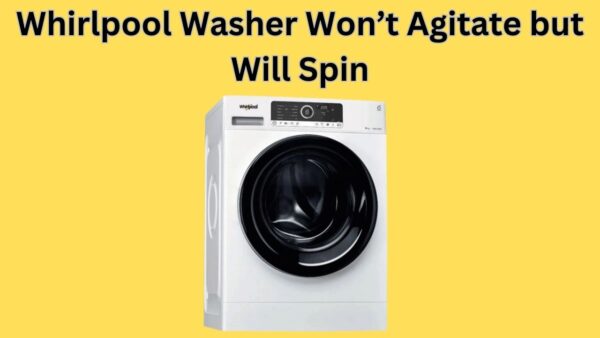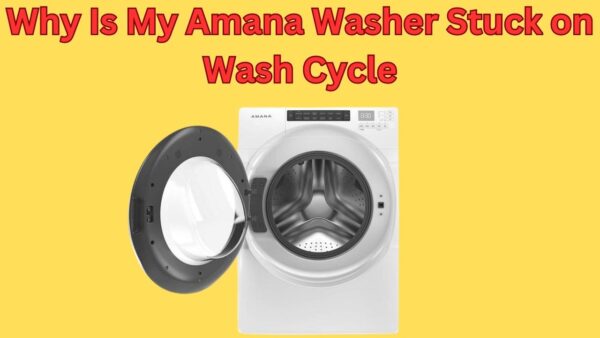Finding that your Whirlpool washer will spin but not agitate can be a frustrating issue.
However, you’re not alone in this predicament and, fortunately, there are several common and straightforward fixes for this problem.
This guide aims to walk you through 10 simple solutions to get your washer back to its optimal condition. Let’s delve in and start troubleshooting your machine.
Whirlpool Washer Won’t Agitate but Will Spin

1. Faulty Agitator Dogs
Agitator dogs are small but crucial components of your washer’s agitator assembly.
They’re essentially ratchets that catch and drive the agitator, enabling it to oscillate and stir your clothes during the wash cycle.
Fix
When these dogs wear out, the agitator can’t function properly, leading to a scenario where your Whirlpool washer will spin but not agitate.
The good news is that this issue can be fixed simply by replacing the worn-out agitator dogs.
This is a relatively straightforward process that can be accomplished with a little DIY know-how and the correct replacement parts, restoring your washer to its full functionality in no time.
2. Damaged Drive Belt
The drive belt of your Whirlpool washer is another integral component that plays a key role in its operation.
Essentially, this belt transfers power from the motor to the drum, enabling the agitator to perform its function.
Over time, the drive belt can wear out or become damaged due to continuous strain or overloading of your washer.
Fix
When this happens, your washer may still spin, but it will fail to agitate.
Luckily, identifying a faulty drive belt is relatively simple and involves inspecting it for visible signs of wear and tear or fraying. If the belt is indeed damaged, it will need to be replaced.
Performing a drive belt replacement is a straightforward DIY process with the correct replacement part and basic tools, ensuring your washer returns to its optimal performance.
3. Worn Out Motor Coupling
The motor coupling in your Whirlpool washer is a safety feature that protects the motor and transmission from part failure.
It’s designed to break if the washer’s inner tub is overloaded or if an object gets caught between the tubs, preventing the motor from burning out.
However, if the motor coupling is worn out, it can lead to a situation where the washer will spin but not agitate.
Fix
Identifying a worn-out motor coupling involves opening up your washer and inspecting the part for damages.
If found to be the culprit, replacing a worn motor coupling is a manageable task for the handy DIYer.
Armed with the right tools and replacement parts, you can have your washer back to its usual agitating self in a short time.
4. Defective Lid Switch
The lid switch on your Whirlpool washer is a crucial mechanism that ensures the safety of the user during operation.
When the lid is open, the switch prevents the washer from agitating or spinning to prevent any accidents.
If this switch becomes defective, it may incorrectly signal that the lid is open, even when it’s not, resulting in a washer that will spin but not agitate.
Fix
Identifying a faulty lid switch involves testing it for continuity using a multimeter.
If the lid switch is defective, it requires replacement. Although the process of replacing a lid switch involves opening up your washer, it’s a task you can accomplish with some patience, the right tools, and a compatible replacement part.
Once fixed, your Whirlpool washer should resume its regular cycle of both spinning and.
5. Broken Agitator Cogs
Agitator cogs, also known as agitator dogs, are vital components in your Whirlpool washer’s agitator assembly, working like ratchets to catch and turn the agitator during the wash cycle.
Over time, these cogs can break due to wear and tear, leading to a situation where the washer spins but doesn’t agitate.
Fix
The tell-tale sign of broken agitator cogs is when the agitator is able to move freely in one direction but not the other.
Fortunately, replacing broken agitator cogs is a relatively simple DIY task. All you need are the right replacement parts and a basic tool kit.
After replacement, your washer’s agitator should operate as expected, restoring the full functionality of your washing machine.
6. Malfunctioning Transmission
The transmission in your Whirlpool washer is a critical component responsible for controlling the movement of the agitator and the spin cycle.
A malfunctioning transmission can result in a scenario where your washer can spin but not agitate.
This issue is more complex than the preceding ones and may require professional intervention.
Symptoms of a faulty transmission include odd noises during operation, leaking oil, or failure to shift between cycles.
Fix
While you can attempt to replace the transmission yourself, it is a labor-intensive task involving careful disassembly and reassembly of the washer.
Therefore, unless you’re highly confident in your DIY skills, it may be best to enlist the services of a trained technician to handle this repair.
Once the transmission issue is addressed, your washer should regain its full functionality and operate as intended.
7. Damaged Drive Motor
The drive motor of your Whirlpool washer is what propels the agitator and the spin cycle.
A damaged drive motor might still enable your washer to spin, but agitation might fail to occur.
Typical signs of a damaged drive motor include strange noises during the agitation cycle or a complete lack of agitation, even though the washer is still capable of spinning.
Fix
Addressing a damaged drive motor is a slightly complex task and typically involves either repairing or replacing the motor.
If you’re adept at handling such tasks, you could attempt the repair yourself.
However, due to the intricacy of the repair and the potential for electrical hazards, it is usually advisable to seek professional assistance.
After the drive motor is repaired or replaced, your washer should return to its normal operation, both agitating and spinning as it should.
8. Faulty Timer Contact Points
The timer contact points in your Whirlpool washer play an essential role in determining the duration of each wash cycle phase.
These contact points can become faulty or corroded over time, leading to improper timing that might result in your washer spinning but not agitating.
Signs of faulty timer contact points can include an irregular washing cycle or the machine failing to progress to the next stage of the cycle.
Fix
Addressing this issue usually involves replacing the entire timer assembly, as individual contact points are not typically sold separately.
Although this task might sound daunting, it can be accomplished with a little diligence, a proper replacement part, and a basic tool kit.
Once the faulty timer assembly is replaced, your washer should function optimally, progressing correctly through all phases of the wash cycle.
9. Worn Clutch Assembly
In your Whirlpool washer, the clutch assembly plays a pivotal role in allowing the washer to switch from agitate to spin during the wash cycle.
If your clutch assembly is worn out, it might result in a scenario where the washer can still spin, but the agitation process fails to occur.
Symptoms of a worn clutch assembly can include excessive noise or a burning smell during the wash cycle, or an inability to engage the agitation process.
Fix
Addressing a worn clutch assembly typically involves replacing it, which can be a complex task due to the assembly’s position in the washer.
Although this repair can be done as a DIY project with the right tools and replacement parts, it may be beneficial to enlist a professional to ensure the task is carried out correctly.
Once the worn clutch assembly is replaced, your Whirlpool washer should be back to performing both its spinning and agitating function efficiently.
10. Defective Drive Block
The Drive Block on your Whirlpool washer is a key component that connects the agitator to the washer’s transmission.
If the drive block becomes worn or damaged, the washer may still be able to spin, but agitation may not occur.
Indicative symptoms of a defective drive block include a loose agitator or an unusual noise during the wash cycle.
Fix
The solution to a defective drive block is to replace it. This task can be somewhat intricate, as it involves disassembling the agitator to access the drive block.
While it’s possible to handle this repair yourself with some mechanical know-how and a suitable replacement part, it may be prudent to call in a professional to ensure the job is done correctly.
Once the defective drive block is replaced, your Whirlpool washer should regain its ability to both agitate and spin as per normal operation.
Conclusion
In conclusion, if your Whirlpool washer won’t agitate but will spin, it’s often indicative of a mechanical issue that needs addressing.
The problem could stem from a faulty agitator assembly, a worn-out drive belt, or a defective lid switch.
It’s crucial to diagnose these problems promptly to prevent further damage and maintain the efficiency of your washer.
Always refer to your washer’s user manual or consult with a professional technician for accurate guidance and safe repairs.
FAQs
Why is my washing machine spinning but not agitating?
Your washing machine may be spinning but not agitating due to a faulty agitator assembly or a damaged drive belt.
Why does my Whirlpool washer spin but not agitate?
Your Whirlpool washer might spin but not agitate if the agitator dogs are worn out or the transmission is defective.
Why is my Whirlpool wash cycle not agitating?
Your Whirlpool wash cycle may not be agitating due to a broken motor coupler or a defective lid switch.
How do I know if my washing machine agitator is broken?
You’ll know your washing machine agitator is broken if your clothes aren’t properly cleaned or if the agitator makes unusual noises or doesn’t move during a wash cycle.
Whirlpool Washer Locked Light Flashing
Beko Washing Machine Problems Reset
Why Is My New Whirlpool Washer So Loud
Dryer Taking Multiple Cycles to Dry
Front Load Washer Filling With Water When Off
Whirlpool Washer Not Agitating Properly
Why Do Clothes Get Stuck Under Agitator
Kenmore Washer Lid Lock Flashing
Speed Queen Wash Spin and Lid Lock Flashing 3 Times
Why Is My Amana Washer Stuck on Wash Cycle


